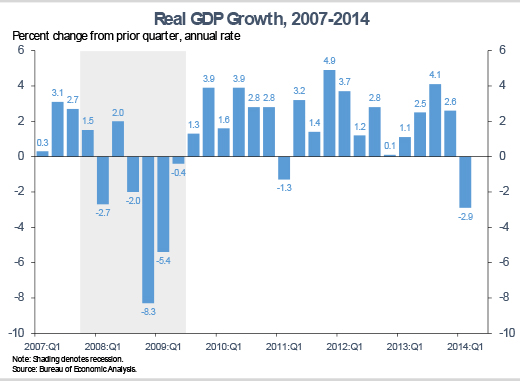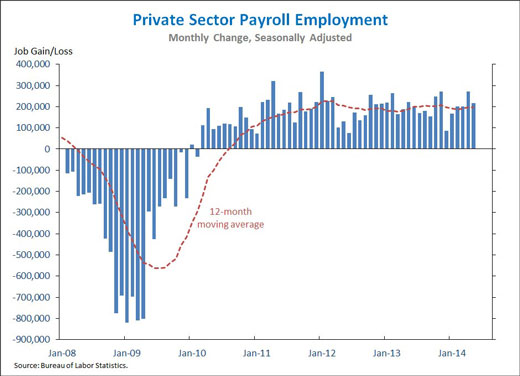Council of Economic Advisers Blog
The Employment Situation in June
Posted by on July 3, 2014 at 9:30 AM EDTThe 1.4 million jobs added in the first half of this year are the most in any first half since 1999. Furthermore, this is the first time since September 1999-January 2000 we have seen total job growth above 200,000 for five straight months. While today’s jobs report is encouraging, many families are still struggling with long-term unemployment and wages that have been stagnant for decades. The President continues to press Congress to take steps to further strengthen the economy, including passing a transportation bill to avoid jeopardizing hundreds of thousands of jobs later this year. But he will also continue to make progress using his own authority to increase economic opportunity, support wage growth, and ensure America’s workplaces are adapting to the 21st century.
FIVE KEY POINTS IN TODAY’S REPORT FROM THE BUREAU OF LABOR STATISTICS
Learn more about , , EconomyThird Estimate of GDP for the First Quarter of 2014
Posted by on June 25, 2014 at 9:30 AM EDTFirst-quarter GDP was revised down today, largely reflecting updated estimates of consumer spending on health care, which was substantially lower than originally reported, as well as exports, which were below the initial estimates. The GDP data can be volatile from quarter to quarter; a range of other data show a more positive picture for the first quarter, and more up-to-date indicators from April and May suggest that the economy is on track for a rebound in the second quarter. The recovery from the Great Recession, however, remains incomplete, and the President will continue to do everything he can to support the recovery, either by acting through executive action or by working with Congress on steps that would boost growth and speed job creation.
FIVE KEY POINTS IN TODAY’S REPORT FROM THE BUREAU OF ECONOMIC ANALYSIS
1. Real gross domestic product (GDP) fell 2.9 percent at an annual rate in the first quarter of 2014, according to the third estimate from the Bureau of Economic Analysis. This drop follows an increase of 3.4 percent at an annual rate in the second half of 2013. The entire decline in overall GDP in the first quarter can be accounted for by a decline in exports and a slowdown in inventory investment, two particularly volatile components of GDP. In addition, several components were likely affected by unusually severe winter weather, including consumer spending on food services and accommodations, which fell for the first time in four years.
 Learn more about Economy
Learn more about EconomyThe Changing Role of Fathers in the Workforce and Family
Posted by on June 9, 2014 at 1:39 PM EDTAs part of the lead-up to the White House Summit on Working Families, we’ve been exploring policies and best practices that help both families and businesses manage the increasingly complicated interaction between work and family-life. Today, Administration officials hosted a discussion—the first of its kind at the White House—on the state of working dads and how businesses can create a win-win culture to enable these fathers to be more involved parents and better employees.
The need to rethink workplace policies to work better for parents is not just about working moms or women—working fathers are a key piece of the story as well. As the data compiled by the Council of Economic Advisers on “The Economics of Fatherhood and Work” show, the role of fatherhood has been changing with fathers taking a more hands-on approach to raising children. This change is both cultural and economic, with families responding to the reality of women’s increased role in the labor market. Nearly two-thirds of children now have either two working parents or a single parent who is working, contributing to the trend of father’s increasingly caring for children. Today, one in fourteen fathers with kids under 18 are single parents—a striking seven-fold increase since 1970—and dads are increasingly staying at home when their wives work.
Learn more about Economy, Working FamiliesThe Employment Situation in May
Posted by on June 6, 2014 at 9:30 AM EDTJob growth exceeded 200,000 for the fourth straight month in May, and businesses have now added over a million jobs so far this year. This month’s report continued the trend of steady job growth. While the consistent pace of job gains means the economy has come a long way in recovering from the Great Recession, the President believes that more can and should be done to strengthen economic growth and expand economic opportunity. Continuing to press ahead using his executive authority wherever possible, the President will hold events next week focused on ways to take action to improve college affordability and support working families.
FIVE KEY POINTS IN TODAY’S REPORT FROM THE BUREAU OF LABOR STATISTICS
1. The private sector has added 9.4 million jobs over 51 straight months of job growth. Today we learned that total nonfarm payroll employment rose by 217,000 in May, mainly reflecting a 216,000 increase in private employment, slightly above the 197,000 average pace over the last twelve months. The three-month moving average of 229,000 is the highest in over a year.
Learn more about , EconomyLeading Academics Discuss Changes in Family Life and Implications for 21st Century Workplaces
Posted by on May 29, 2014 at 11:44 AM EDTIn advance of the White House Summit on Working Families next month, we have engaged working families, business leaders, and other stakeholders from around the country to determine how best to meet the needs of 21st century families and workplaces. We continued this important conversation by meeting with academics to discuss the most recent research on working families, including changing demographics, modern marriage, workplace flexibility, and effective management practices that boost companies’ bottom lines by boosting the productivity of their workers.
At the meeting, researchers painted a picture of changing family life with fewer families having separate roles for men and women and more families struggling to combine work with their caregiving responsibilities. They also discussed the differing needs of families across the income distribution. College-educated women have children later when they are in jobs that are more demanding, but have greater income and potential for flexibility. In contrast, less-educated women are having children younger, in their early to mid-twenties, when they are in less stable jobs that are less likely to provide them with access to family and medical leave. Middle-class couples are marrying less often and later in life, cohabitation has become more common across all income levels, and divorce rates have fallen, although most notably among highly educated couples.
Research has shown that parents, particularly those who are highly educated, are spending more time with children, leaving less time for leisure. The role of mothers and fathers are converging as men are spending more time on housework and child care and both men and women are increasingly expecting women to be in the labor force. At the same time, both men and women are increasingly saying that work is interfering with family life. And since Americans are living and working longer, periods where workers will need to take time out of the labor force to provide care for themselves, their children, or their aging parents will only become more common.
Learn more aboutNew Report: The All-of-the-Above Energy Strategy as a Path to Sustainable Economic Growth
Posted by on May 29, 2014 at 11:30 AM EDT“We can’t have an energy strategy for the last century that traps us in the past. We need an energy strategy for the future – an all-of-the-above strategy for the 21st century that develops every source of American-made energy.” – President Barack Obama, March 15, 2012
The U.S. energy sector is undergoing a profound transformation. The United States is producing more oil and natural gas, is generating more electricity from renewables such as wind and solar, and is consuming less petroleum while holding electricity consumption constant. As detailed in today’s report from the Council of Economic Advisers, these developments have had substantial economic and energy security benefits, and they are helping to reduce carbon emissions in the energy sector and thereby tackle the challenge posed by climate change. These trends have been supported and advanced by President Obama’s All-of-the-Above energy strategy.
The President’s All-of-the-Above energy strategy has three key goals:
- To support economic growth and job creation
- To enhance energy security
- To deploy low-carbon energy technologies and lay the foundation for a clean energy future
KEY POINTS IN TODAY’S REPORT FROM THE COUNCIL OF ECONOMIC ADVISERS
1. Decades-long trends in energy use are being reversed. The U.S. is the world’s leading producer of petroleum and natural gas, surpassing long-standing petro-states Saudi Arabia and Russia. Accompanying these increases has been an unexpected turnaround in petroleum and gasoline demand; while industry-standard projections by the Energy Information Administration from as late as 2006 suggested ever-increasing consumption of oil and gasoline, U.S. gasoline consumption has fallen by 5.5 percent since 2007, or nearly half a million barrels per day. At the same time, production of renewable energy has increased rapidly. Since 2008, electricity production generation from wind has tripled while solar generation is up more than ten-fold.
Learn more about , Economy, Energy and Environment
- &lsaquo previous
- …
- 5
- 6
- 7
- 8
- 9
- 10
- 11
- 12
- 13
- …
- next &rsaquo
White House Blogs
- The White House Blog
- Middle Class Task Force
- Council of Economic Advisers
- Council on Environmental Quality
- Council on Women and Girls
- Office of Intergovernmental Affairs
- Office of Management and Budget
- Office of Public Engagement
- Office of Science & Tech Policy
- Office of Urban Affairs
- Open Government
- Faith and Neighborhood Partnerships
- Social Innovation and Civic Participation
- US Trade Representative
- Office National Drug Control Policy
categories
- AIDS Policy
- Alaska
- Blueprint for an America Built to Last
- Budget
- Civil Rights
- Defense
- Disabilities
- Economy
- Education
- Energy and Environment
- Equal Pay
- Ethics
- Faith Based
- Fiscal Responsibility
- Foreign Policy
- Grab Bag
- Health Care
- Homeland Security
- Immigration
- Innovation Fellows
- Inside the White House
- Middle Class Security
- Open Government
- Poverty
- Rural
- Seniors and Social Security
- Service
- Social Innovation
- State of the Union
- Taxes
- Technology
- Urban Policy
- Veterans
- Violence Prevention
- White House Internships
- Women
- Working Families
- Additional Issues


